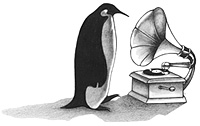 |
Penguin Recording’s more than 25 years of experience handling virtually every brand and every formula of source media, assures the safety of your master. We are able to transfer the content of unstable media by properly preparing the tape while retaining the integrity of the master.


Analog tape is made up of multiple layers joined by an adhesive. Molecular breakdown of the adhesive and absorption of moisture by the tape’s lubricants causes some tapes to “stick” and “shed” when traveling through a tape machine’s transport. This is due to the formula of the binder that was used to manufacture most tapes beginning in 1973; it takes approximately nine years after manufacture for the problem to occur.
To temporarily alleviate the problems of sticking and shedding, the primary method of stabilization is to cure the tape at a constant temperature with circulating air. When performed correctly, this process is benign and can be repeated as needed. The baking process serves to temporarily correct the problem by slowly re-setting the molecules and removing the moisture. At Penguin, this is done in Blue M laboratory-grade environmental test chambers that maintain an unvarying temperature of 125°F and do so without subjecting the tapes to harmful magnetic fields. The length of baking time varies from hours to days, depending on mass (the width and length of the tape). The baking process stabilizes the tape for one to three weeks.
Refrigerating is an accepted alternative to baking, but requires a commitment to a greater length of time to be effective. This process involves sealing the tapes with desiccant in a refrigerated environment. There has been significantly less experimentation and testing of this process, and its effects are not well understood.


Using customized Ampex tape machines with Aria audiophile, Class A, discrete
electronics, high-quality convertors, and direct point-to-point
interconnect, we offer the best analog to digital transfers. We painstakingly align
our tape machines for level, eq, and azimuth in order to achieve the highest level of accuracy
when reproducing the source material. Top Top
|



